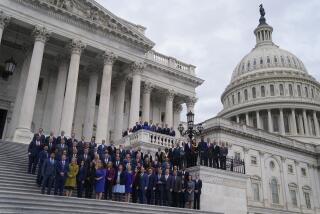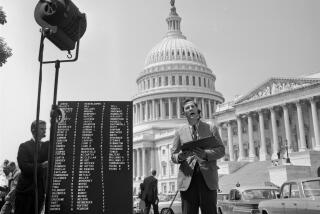Celebrate Independence Day with these 17 books by immigrant authors
It’s no surprise that the Fourth of July is one of the most popular dates for immigrants to America to take their citizenship oaths. The United States is a nation of immigrants, and that’s been the case for the entirety of the nation’s history.
Immigrants have left their mark on every part of the U.S., and literature is no exception. The writings of immigrants helped bring about American independence and the ratification of the U.S. Constitution, and have been responsible for bringing about social change and changing the course of American literature.
In honor of immigrants’ contributions to our country, here are 17 books by Americans and American residents born abroad that have been significant to the nation’s history and culture.
Thomas Paine, “Common Sense” (1776)
Paine was born in England and moved to the American colonies in 1774 when he was 37. It didn’t take long for him to make a splash — just over a year after his arrival, he published the pamphlet “Common Sense,” which laid out the case for American independence from Great Britain. “The cause of America is in a great measure the cause of all mankind,” he famously wrote.
Alexander Hamilton, James Madison and John Jay, “The Federalist Papers” (1787-88)
The United States as we know it likely wouldn’t exist without this series of 85 essays written by three of the nation’s Founding Fathers. The papers were written to urge lawmakers to ratify the U.S. Constitution, which they did, after months of debate. Hamilton, the author of 51 of the 85 essays, was an immigrant, born in the Caribbean island of Nevis — he came to the U.S. as a teenager, and went on to fight in the Revolutionary War before becoming the nation’s first secretary of the Treasury. (Not to mention the subject of a smash hit Broadway show).
Jacob Riis, “How the Other Half Lives: Studies Among the Tenements of New York” (1890)
Riis, an immigrant from Denmark and pioneering photojournalist, exposed the horrible conditions of the New York City tenements with his shocking book “How the Other Half Lives.” The popularity of the book led to the New York State Tenement House Act of 1901, which mandated safety measures including toilets and windows for all residential buildings in the city.
John Muir, “The Mountains of California” (1901)
Few authors appreciated the beauty of America’s landscape more than Muir, the conservationist who co-founded the Sierra Club. Born in Scotland, Muir immigrated to America with his family when he was 11 years old. Muir would go on to spend a decade studying the Sierra Nevadas; this book is his love letter to the mountain range, where there’s now a 200-mile hiking trail named after him. His influence on nature writing lasts to this day.

Anzia Yezierska, “Bread Givers” (1925)
Polish-born author Yezierska is widely credited with creating one of the best novels about the Jewish immigrant experience in America. A coming-of-age story about an independent-minded girl living in 1920s New York, “Bread Givers” is still widely read today for its sharp prose and its insights into the experience of Jewish Americans in the early 20th century.
Henry Roth, “Call It Sleep” (1934)
Roth was a young child when he immigrated to the U.S. in 1908 with his family from what is now Ukraine. At 28 he published his novel “Call It Sleep,” about a young immigrant boy growing up in a New York slum. The modernist book was out of print for decades after its initial publication, but gained a new following after being reissued in 1960.
Isaac Asimov, “The Foundation Trilogy” (1942-53)
Born in Russia to Jewish parents, Asimov moved with his family to New York when he was a toddler. He would grow up to become one of America’s best-known science fiction writers, starting with “The Foundation Trilogy,” which began as short fiction and became three books published from 1951-53 (and later a fourth). Like his fellow writers in the Golden Age of science fiction, his imagination helped inspire those who created America’s space program.
Vladimir Nabokov, “Lolita” (1955)
The story of a professor who becomes obsessed with his 12-year-old stepdaughter and goes on to sexually assault her, Nabokov’s magnum opus was instantly controversial when it was published, with many readers horrified by the story line. The book has become one of the most enduring novels of the 20th century, however, with countless authors citing it as an inspiration. A native of St. Petersburg, Russia, Nabokov fled war-torn Europe for the U.S. in 1940.
Louis Chu, “Eat a Bowl of Tea” (1961)
A sadly out-of-print landmark of Asian American literature, Chu’s novel follows a young couple in the Chinatown neighborhood of New York in the mid-20th century. The novel, Chu’s only published book, is credited with being one of the first realistic literary portrayals of Chinese Americans. Chu was a native of China who moved to New Jersey and worked as a radio host.
Hannah Arendt, “Eichmann in Jerusalem: A Report on the Banality of Evil” (1963)
German-born philosopher Arendt escaped Nazi-occupied France in 1940 and moved to New York in 1941. The author of several influential works, her book “Eichmann in Jerusalem,” about the trial of the Nazi war criminal, remains one of her most well-known and most controversial for the way it takes on questions of morality, responsibility and the Nazis.
Isabel Allende, “The House of the Spirits” (1982)
Allende’s debut novel thrilled critics when it was published in English in 1985. Considered one of the best magical-realist novels, the book follows four generations of a Chilean family beset by political and cultural turmoil. Allende, a cousin of former Chilean President Salvador Allende, became a U.S. citizen in 1993, and was awarded the Presidential Medal of Freedom by President Obama in 2014.
Art Spiegelman, “Maus” (1991)
The son of a Polish Jewish couple, Spiegelman was born in Sweden and immigrated to the U.S. with his family at age 3. A legend in the underground comics scene, he published the graphic novel “Maus,” a Holocaust story with the characters rendered as animals, in 1991. The book is now considered one of the best graphic novels in American history, as well as a classic of Holocaust literature.
Cristina García, “Dreaming in Cuban” (1992)
García fled Communist Cuba as a young child with her family in 1961. She worked as a journalist before publishing “Dreaming in Cuban,” her first novel, to critical acclaim. The novel tells the story of a family whose lives are torn apart by the Cuban Revolution of the 1950s.
Edwidge Danticat, “Breath, Eyes, Memory” (1994)
A native of Port-au-Prince, Haiti, Danticat moved to New York when she was 12. Her debut novel, published when the author was 25 years old, about a Haitian girl reunited with her mother in New York, garnered rave reviews, and is widely considered one of the best American novels of the 1990s.

Jhumpa Lahiri, “Interpreter of Maladies” (1999)
Lahiri’s debut book is a short story collection that depicts the lives of people who cross between India and America. It was published to critical acclaim and won the Pulitzer Prize for Fiction. Lahiri was born in London and moved to the U.S. when she was 2; she spent most of her childhood in Rhode Island.
Viet Thanh Nguyen, “Nothing Ever Dies: Vietnam and the Memory of War” (2016)
Although it was published only two years ago, Nguyen’s nonfiction book is already considered by many to be one of the best about the Vietnam War. Nguyen looks at the war through a cultural lens, examining how it’s been remembered by Americans and the Vietnamese. Nguyen, a Times critic at large, is a native of Vietnam who came to the U.S. as a refugee with his family after North Vietnamese forces retook Saigon.
Masha Gessen, “The Future Is History: How Totalitarianism Reclaimed Russia” (2017)
Gessen, a journalist and LGBTQ rights activist, came to the U.S. from the then Soviet Union in the early 1980s. In her latest book, the winner of the 2017 National Book Award for Nonfiction, she paints a chilling picture of the rise of authoritarianism in the country accused of tampering with the 2016 American presidential election.
More to Read
Sign up for our Book Club newsletter
Get the latest news, events and more from the Los Angeles Times Book Club, and help us get L.A. reading and talking.
You may occasionally receive promotional content from the Los Angeles Times.










